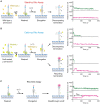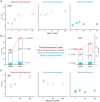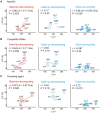Transcriptional pause extension benefits the stand-by rather than catch-up Rho-dependent termination
- PMID: 36762473
- PMCID: PMC10085680
- DOI: 10.1093/nar/gkad051
Transcriptional pause extension benefits the stand-by rather than catch-up Rho-dependent termination
Abstract
Transcriptional pause is essential for all types of termination. In this single-molecule study on bacterial Rho factor-dependent terminators, we confirm that the three Rho-dependent termination routes operate compatibly together in a single terminator, and discover that their termination efficiencies depend on the terminational pauses in unexpected ways. Evidently, the most abundant route is that Rho binds nascent RNA first and catches up with paused RNA polymerase (RNAP) and this catch-up Rho mediates simultaneous releases of transcript RNA and template DNA from RNAP. The fastest route is that the catch-up Rho effects RNA-only release and leads to 1D recycling of RNAP on DNA. The slowest route is that the RNAP-prebound stand-by Rho facilitates only the simultaneous rather than sequential releases. Among the three routes, only the stand-by Rho's termination efficiency positively correlates with pause duration, contrary to a long-standing speculation, invariably in the absence or presence of NusA/NusG factors, competitor RNAs or a crowding agent. Accordingly, the essential terminational pause does not need to be long for the catch-up Rho's terminations, and long pauses benefit only the stand-by Rho's terminations. Furthermore, the Rho-dependent termination of mgtA and ribB riboswitches is controlled mainly by modulation of the stand-by rather than catch-up termination.
© The Author(s) 2023. Published by Oxford University Press on behalf of Nucleic Acids Research.
Figures








Similar articles
-
Compatibility of termination mechanisms in bacterial transcription with inference on eukaryotic models.Biochem Soc Trans. 2024 Apr 24;52(2):887-897. doi: 10.1042/BST20231229. Biochem Soc Trans. 2024. PMID: 38533838 Review.
-
Rho-dependent transcription termination proceeds via three routes.Nat Commun. 2022 Mar 29;13(1):1663. doi: 10.1038/s41467-022-29321-5. Nat Commun. 2022. PMID: 35351884 Free PMC article.
-
Rho-dependent transcription termination: a revisionist view.Transcription. 2021 Aug;12(4):171-181. doi: 10.1080/21541264.2021.1991773. Epub 2021 Oct 27. Transcription. 2021. PMID: 34705601 Free PMC article. Review.
-
Functionally important components of the transcription elongation complex involved in Rho-dependent termination.FEMS Microbiol Lett. 2025 Jan 10;372:fnae111. doi: 10.1093/femsle/fnae111. FEMS Microbiol Lett. 2025. PMID: 39730149
-
Regulation of rho-dependent transcription termination by NusG is specific to the Escherichia coli elongation complex.Biochemistry. 2000 May 9;39(18):5573-85. doi: 10.1021/bi992658z. Biochemistry. 2000. PMID: 10820031
Cited by
-
A new twist on PIFE: photoisomerisation-related fluorescence enhancement.ArXiv [Preprint]. 2023 Jul 10:arXiv:2302.12455v2. ArXiv. 2023. Update in: Methods Appl Fluoresc. 2023 Oct 12;12(1). doi: 10.1088/2050-6120/acfb58. PMID: 36866225 Free PMC article. Updated. Preprint.
-
Single-mode termination of phage transcriptions, disclosing bacterial adaptation for facilitated reinitiations.Nucleic Acids Res. 2024 Aug 27;52(15):9092-9102. doi: 10.1093/nar/gkae620. Nucleic Acids Res. 2024. PMID: 39011892 Free PMC article.
-
A new twist on PIFE: photoisomerisation-related fluorescence enhancement.Methods Appl Fluoresc. 2023 Oct 12;12(1):012001. doi: 10.1088/2050-6120/acfb58. Methods Appl Fluoresc. 2023. PMID: 37726007 Free PMC article. Review.
-
Co-transcriptional gene regulation in eukaryotes and prokaryotes.Nat Rev Mol Cell Biol. 2024 Jul;25(7):534-554. doi: 10.1038/s41580-024-00706-2. Epub 2024 Mar 20. Nat Rev Mol Cell Biol. 2024. PMID: 38509203 Free PMC article. Review.
-
Sm-like protein Rof inhibits transcription termination factor ρ by binding site obstruction and conformational insulation.bioRxiv [Preprint]. 2023 Aug 31:2023.08.30.555460. doi: 10.1101/2023.08.30.555460. bioRxiv. 2023. Update in: Nat Commun. 2024 Apr 15;15(1):3186. doi: 10.1038/s41467-024-47439-6. PMID: 37693585 Free PMC article. Updated. Preprint.
References
-
- Landick R. Transcriptional pausing as a mediator of bacterial gene regulation. Annu. Rev. Microbiol. 2021; 75:291–314. - PubMed
-
- Nickels B.E., Roberts C.W., Sun H., Roberts J.W., Hochschild A.. The σ70 subunit of RNA polymerase is contacted by the λ Q antiterminator during early elongation. Mol. Cell. 2002; 10:611–622. - PubMed
-
- Naftelberg S., Schor I.E., Ast G., Kornblihtt A.R.. Regulation of alternative splicing through coupling with transcription and chromatin structure. Annu. Rev. Biochem. 2015; 84:165–198. - PubMed
Publication types
MeSH terms
Substances
LinkOut - more resources
Full Text Sources
Molecular Biology Databases

